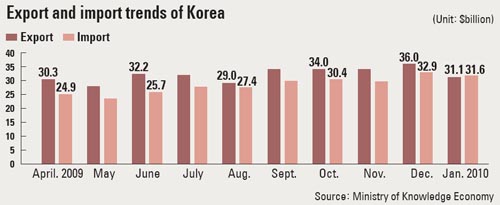Exports grow at fastest pace in over two decades

In the report of January export-import trend, the Ministry of Knowledge Economy said exports last month amounted to $31.08 billion. Although they fell from December’s $36 billion, overseas exports in January were up 47.1 percent from the same month in 2009. That is the highest on-year growth since August of 1988, when the growth was 52.6 percent.
Still, the month saw a $468 million trade deficit, due to the growth of imports. Imports rose 26.7 percent from a year earlier to $31.55 billion, growing the quickest since a 45.4 percent growth rate was reported in September 2008.
The deficit in January compares to a 2009 deficit of $3.77 billion and one in 2008 of $4.04 billion.
“We often see a trade deficit in January due to increased imports of fuel sources for heating, so it is not worrisome,” Lee Dong-geun, deputy minister for international trade and investment policy at the ministry, said at a media briefing.
The overall trade surplus last year amounted to $41 billion, the highest on record, thanks to the surplus streak between February and December.
“Compared with last year, the size of deficit in January dwindled significantly,” Lee said.
Most of the major export items saw a significant growth last month, the ministry said.
Car parts exports increased 158 percent over a year earlier. Exports of semiconductors also rose 121.6 percent, followed by home electronic appliances at 89.9 percent, petrochemical products at 75.6 percent and cars at 64.2 percent. By region, exports to China grew sharply. For the first 20 days of the month, exports to China accounted for 29.8 percent of all the exports, compared to 23.8 percent of exports during all of last year.
The growth of imports was attributed to the growing consumption of oil and raw materials and their increased prices. Imports of crude oil, for instance, rose as much as 44.1 percent last month from a year earlier. As a whole, average daily imports rose 20.7 percent to $1.4 billion last month, marking the second straight month average daily imports increased.
At the beginning of the year the ministry had expected the trade surplus this year will amount to around $20 billion, a target which the ministry said yesterday is still effective.
“We expect a double-digit trade surplus in February thanks to the growing exports of information and technology products and ships,” said the ministry.
Go You-sun, an economist at Daewoo Securities, forecast the trade surplus this year will be $14 billion to $15 billion due to growing imports and appreciation of the won.
“The recent restrengthening of the dollar, however, could work in favor of Korea’s trade surplus,” Go said.
By Moon Gwang-lip [joe@joongang.co.kr]










with the Korea JoongAng Daily
To write comments, please log in to one of the accounts.
Standards Board Policy (0/250자)